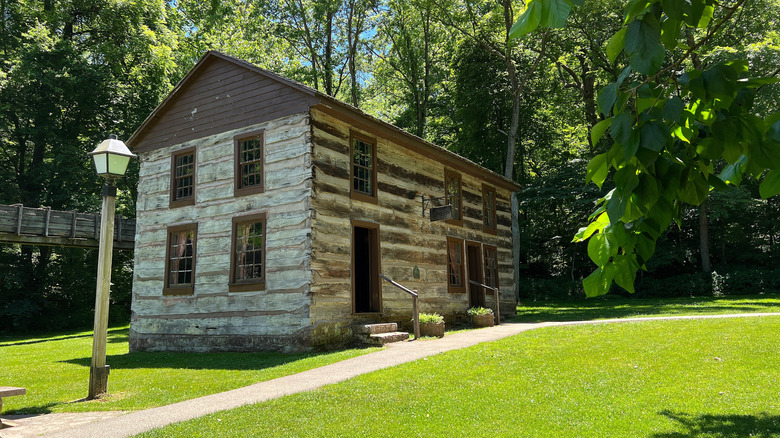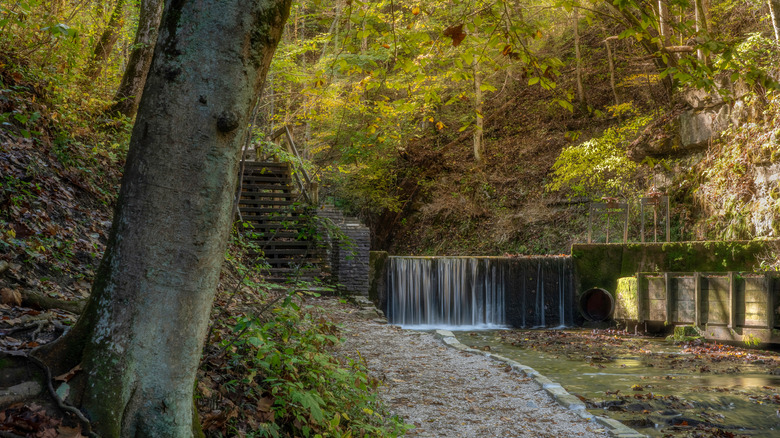Southern Indiana's Lush State Park Offers Adventurous Hiking Trails, Caves, And A Historic Village
Indiana may not have the immediate appeal of Midwestern states like Michigan or Minnesota, but dig a bit deeper and you'll find an abundance of beauty. Along with an underrated wilderness area with hidden wetlands, the Hoosier State is home to the historic Spring Mill State Park. Visitors will find plenty of ways to stay busy in this outdoor wonderland, including a variety of hiking paths, a thrilling boat tour through a cave, and a historic Pioneer Village that lets you glimpse back into early 1800s America.
Spring Mill State Park is an hour northwest of Louisville and just under two hours south of Indianapolis. Splitting the difference between an outdoor history museum and a traditional state park, it's home to several unique activities. Sitting on the location of an old village from the 19th century, you'll have a chance to not just explore cave systems and winding trails into the forest, but also preserved buildings from early on in America's history. There's also an on-site inn, so you don't have to travel elsewhere to spend the night and unwind. Whether you're interested in American history, outdoor adventures, or venturing into the earth with a bit of spelunking, Spring Mill State Park is a fun destination in southern Indiana.
Time travel with Pioneer Village at Spring Mill State Park
One of the most incredible attractions of Spring Mill State Park is its Pioneer Village. Unlike most state parks, which offer hiking trails and little more, this on-site Pioneer Village is a restoration of an actual village that was founded here around 1814. It consists of multiple structures, such as a grist mill, school, tavern, distillery, and several shops and houses. All told, there is a total of 20 buildings to enjoy.
The limestone grist mill is at the center of the settlement. Soaring three stories above the other buildings, park employees periodically ran the grist mill to grind corn into cornmeal. This experience has been put on hiatus for repairs at the time of this writing, but you can still enjoy the mill and its inner workings. During peak season, park employees can be seen wandering the settlement in clothes representative of those from 1863 — turning it into a living outdoor museum. It's a bit like a one-of-a-kind living history farm in North Carolina, as it provides an in-depth look at life in America many years ago.
The rest of the structures aren't quite as large as the grist mill, but they're no less entertaining. You'll cross over a variety of wooden bridges and the Mill Creek as you explore them all, most of which are fully decorated on the inside to provide a glimpse into what they would have looked like centuries ago. Be sure to check out the many info markers and brochures available at the park, as they'll give you impressive details about the buildings' original purposes.
Hikes and caves at Spring Mill State Park
Ready to step away from civilization and explore the 1,300 acres of surrounding woodland? Spring Mill State Park doesn't have a massive trail network, but it does have several short paths suitable for most skill levels. The longest is a rugged loop trail starting near the Donaldson parking lot. Winding for 2.5 miles past sinkholes, Bronson Cave, an overlook, and pristine sections of forest, it's one of the best hikes in the park.
A few of the caves at Spring Mill State Park are open for spelunking, though you'll need to register in advance with the Indiana Karst Conservancy. They'll require you to complete online training, ensuring you understand the risks of white-nose syndrome (a life-threatening fungus affecting bats) and how to properly decontaminate after the activity. An easier option is to sign up for a Twin Cave Boat Tour. These guided expeditions ferry you 500 feet into the darkness, granting views of rarely seen rock formations and a chance to see the endangered blind cavefish.
If you want to learn more about the plants and animals calling this part of the country home, step into the Nature Center. The rustic building features live animal displays, a children's area, and a chance to listen to a variety of naturalist talks. Have some extra time on your hands? Head north to an artsy town serving as the gateway to Brown County State Park.


